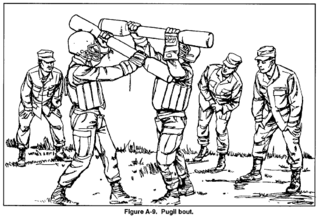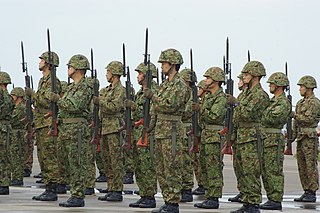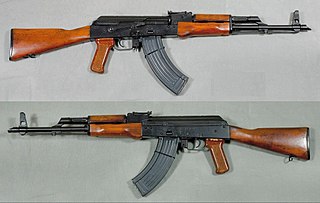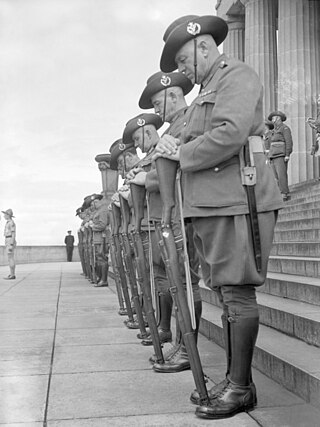
Infantry is a military specialization of military personnel who engage in ground combat on foot. Infantry generally consists of light infantry, irregular infantry, heavy infantry, mountain infantry, motorized infantry, mechanized infantry, airborne infantry, air assault infantry, and naval infantry.

A bayonet is a knife, dagger, sword, or spike-shaped weapon designed to fit on the end of the muzzle of a rifle, carbine, musket or similar firearm, allowing it to be used as a spear-like weapon. From the early 17th to the early 20th century, it was a melee weapon used by infantry for offensive and/or defensive tactics. Today, it is considered an ancillary weapon or weapon of last resort, although it is still used for ceremonial purposes.

A quarterstaff, also short staff or simply staff is a traditional European pole weapon, which was especially prominent in England during the Early Modern period.

The .45 Reising submachine gun was manufactured by Harrington & Richardson (H&R) Arms Company in Worcester, Massachusetts, USA, and was designed and patented by Eugene Reising in 1940. The three versions of the weapon were the Model 50, the folding stock Model 55, and the semiautomatic Model 60 rifle. Over 100,000 Reisings were ordered during World War II, and were initially used by the United States Navy, Marine Corps, and the United States Coast Guard, though some were shipped to Canadian, Soviet, and other allied forces to fight the Axis powers.

Marching refers to the organized, uniformed, steady walking forward in either rhythmic or route-step time; and, typically, it refers to overland movements on foot of military troops and units under field orders. Marching is often performed to march music and is typically associated with military and civilian ceremonial parades. It is a major part of military basic training in most countries and usually involves a system of drill commands.

Drill commands are generally used with a group that is marching, most often in military foot drills or in a marching band. Drill commands are usually heard in major events involving service personnel, reservists and veterans of a country's armed forces, and by extension, public security services and youth uniformed organizations.

A strike is a directed, forceful physical attack with either a part of the human body or with a handheld object, intended to cause blunt or penetrating trauma upon an opponent.
Strikes can be offensive moves in professional wrestling, that can sometimes be used to set up an opponent for a hold or for a throw. There are a wide variety of strikes in pro wrestling, and many are known by several different names. Professional wrestlers frequently give their finishers new names. Occasionally, these names become popular and are used regardless of the wrestler performing the technique.

The Marine Corps Martial Arts Program is a combat system developed by the United States Marine Corps to combine existing and new hand-to-hand and close quarters combat techniques with morale and team-building functions and instruction in the warrior ethos. The program, which began in 2001, trains Marines in unarmed combat, edged weapons, weapons of opportunity, and rifle and bayonet techniques. It also stresses mental and character development, including the responsible use of force, leadership, and teamwork.
A gunstock or often simply stock, the back portion of which is also known as a shoulder stock, a buttstock, or simply a butt, is a part of a long gun that provides structural support, to which the barrel, action, and firing mechanism are attached. The stock also provides a means for the shooter to firmly brace the gun and easily aim with stability by being held against the user's shoulder when shooting the gun, and helps to counter muzzle rise by transmitting recoil straight into the shooter's body.
The RK 95 TP, officially 7.62 RK 95 TP and commercially known as the M95, is a 7.62×39mm Finnish assault rifle adopted in relatively small numbers by the Finnish Defence Forces in the 1990s. The RK 95 TP originally featured many improvements including a fire control selector and a muzzle device that enabled the firing of rifle grenades, the attachment of a suppressor, or bayonet. The rifle is only used by Finland.

A pugil stick is a heavily padded pole-like training weapon used since the early 1940s by military personnel in training for rifle and bayonet combat. The pugil stick is similar to a quarterstaff or Japanese bo, and may be marked to indicate which end represents the bayonet and which the rifle butt. Dr. Armond H. Seidler (1919-2017) of the University of New Mexico invented the Pugil Stick training method during World War II. It was initially adopted by the United States Marine Corps, but was later included in United States Army combat training as well. Dr. Seidler received an award from the Marine Corps for his invention.

Throughout the history of gloved boxing styles, techniques and strategies have changed to varying degrees. Ring conditions, promoter demands, teaching techniques, and the influence of successful boxers are some of the reasons styles and strategies have fluctuated.

Present arms is a two-part drill command used by many militaries and public safety professionals in the world as a sign of respect. It comes from the old British command "Arms to the present!"

Canne de combat is a French combat sport. As weapon, it uses a canne or cane designed for fighting. Canne de combat was standardized in the 1970s for sporting competition by Maurice Sarry. The canne is very light, made of chestnut wood and slightly tapered. A padded suit and a fencing mask are worn for protection.
The Model L is a Spanish 5.56×45mm NATO assault rifle developed in the late 1970s at the state-owned small arms research and development establishment CETME located in Madrid. The rifle retains many of the proven design elements the institute had used previously in its CETME Model 58 battle rifles.

The AKM is an assault rifle designed by Soviet small arms designer Mikhail Kalashnikov in 1959. It was developed as a replacement to the AK-47 introduced a decade prior.

Reverse arms and the related rest on arms reversed are military drill commands used as a mark of respect at funerals and on occasions of mourning, especially in the armed forces of Commonwealth nations. When marching in reverse arms the soldier's weapon is held pointing behind them and grasped behind their back. When resting on reversed arms the weapon points towards the ground and the eyes are lowered.















